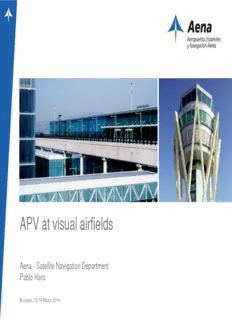
APV at visual airfields PDF
Preview APV at visual airfields
APV at visual airfields Aena - Satellite Navigation Department Pablo Haro Brussels, 12-14 March 2014 TABLE OF CONTENTS Introduction Current regulations in Spain A case study: La Perdiz aerodrome ICAO Annex 14 –new definition of non-instrument runway Conclusions APV at visual airfields Satellite Navigation Department 12-14 March 2014 2 INTRODUCTION • Instrument Approach Procedures (IAPs) based on satellite navigation offer a means of serving smaller and less well equipped aerodromes. • IAP, in particular APV, can increase safety and accessibility at those aerodromes. • Requests for IAP from a number of small aerodromes in Spain. APV at visual airfields Satellite Navigation Department 12-14 March 2014 3 CURRENT REGULATIONS IN SPAIN (I) Initial guidance received in June 2013 from the Spanish National Supervisory Authority (AESA) concerning current requirements for the implementation of APV at visual airfields. Runway requirements • The runway should at least meet the Annex 14 requirements for non-precision approach (NPA) runways with OCH ≥ 90 m (300 ft). Limitation and removal of obstacles • The Obstacle Limitation Surfaces (OLS) and the obstacle limitation requirements should at least meet the Annex 14 requirements for NPA runways with OCH ≥ 90 m (300 ft). On-board navigation systems and RNP APCH approval • Aircraft and crew flying RNP APCH procedures down to LPV minima have to be approved according to EASA AMC 20-27/28 or equivalent. APV at visual airfields Satellite Navigation Department 12-14 March 2014 4 CURRENT REGULATIONS IN SPAIN (II) Public/Restricted use aerodrome Commercial air transport operations of passengers (including aerotaxis), cargo and mail. Maintenance of commercial transport aircraft. Public use aerodrome Flight school base (commercial and aerotaxi pilots) Touristic flights base Other types of activity Restricted use aerodrome Public use aerodrome • Compatibility of the new instrument approach procedures with the nearby airspace; • Aerodrome Flight Information Service (AFIS) at least; • Flight Information Zone (FIZ) in the airspace associated to the AFIS aerodrome; • Approval by CIDEFO joint commission (Ministries of Defence and Development); • Both the aerodrome and the IFR procedures included in AIP-Spain; • Certified aeronautical meteorological station. APV at visual airfields Satellite Navigation Department 12-14 March 2014 5 CURRENT REGULATIONS IN SPAIN (III) Restricted use aerodrome • Modification of the aerodrome authorisation: – Compatibility with the nearby airspace; – Environmental evaluation; – Review of administrative documentation and technical study of the aerodrome; – Inspection of the aerodrome infrastructure. • Establishment of a controlled airspace (i.e. ATC) around the aerodrome – Based on an article of the Rules of the Air drafted before the regulation establishing the possibility of AFIS. • Approval by CIDEFO joint commission (Ministries of Defence and Development); • Both the aerodrome and the IFR procedures included in AIP-Spain. • Certified aeronautical meteorological station. APV at visual airfields Satellite Navigation Department 12-14 March 2014 6 A CASE STUDY: LA PERDIZ AERODROME (I) • Ongoing study in the frame of the EC 7FP ACCEPTA project. • Study on EGNOS-based IAPs at visual runway-ends. • A case study: La Perdiz (LEIZ) aerodrome www.lanava.net – Private aerodrome (not open to public use) – Prior Permission Required (PPR) is mandatory – Runway 1917 x 23 m asphalt – Class G airspace (up to FL150) – VFR – very low level of traffic – Business jets (LPV-capable aircraft) • With current regulations for IAP: – Runway requirements – AFIS – COM – MET – Lighting the business case is not positive. APV at visual airfields Satellite Navigation Department 12-14 March 2014 7 A CASE STUDY: LA PERDIZ AERODROME (II) Outcome of the ACCEPTA study: • Runway: the instrument runway strip requirement is not met. • ATS: IAPs only economically feasible if neither ATC nor AFIS is considered. – Safety of VFR / IFR operations could likely be ensured based on: o adequate airspace structure, (Aerodrome Traffic Zone – ATZ); o flight planning and operating procedures; o No more than one aircraft at a time to use the IAP; o local air-to-air radio frequency. – currently not permitted by Spanish regulations. • Communications: LEIZ radio frequency to inform on wind, QNH and temperature. – as current ops. • MET: local non-certified station. QNH based on nearby airports plus a safety margin. • Runway lighting (for H24): edge, end, threshold lights. APV at visual airfields Satellite Navigation Department 12-14 March 2014 8 ANNEX 14 – NEW DEFINITION OF NON-INSTRUMENT RUNWAY • Non-instrument runway. A runway intended for the operation of aircraft using visual approach procedures or an instrument approach procedure down to minima equal to or better than VMC. • The runway infrastructure requirements need not be any different than visual procedures to non-instrument runways since the final segment will always have the same VMC requirements. • Change being proposed by ICAO for introduction on the 13th November 2014 (Amendment 11-B). APV at visual airfields Satellite Navigation Department 12-14 March 2014 9 CONCLUSIONS • Current regulations do not facilitate the deployment of APV procedures at visual airfields. • In fact, with current regulations, it is unlikely that small aerodromes will perform the necessary investments to allow the use of instrument procedures. • On the other hand, it is acknowledged that the use of instrument procedures in such aerodromes would enhance safety and accessibility. • Amendment of ICAO Annex 14 (Nov 2014) – IAP possible at non-instrument runways. • Instrument procedures have to be based on a safety case and cost-benefit analysis. • Need for a uniform European policy and regulation. APV at visual airfields Satellite Navigation Department 12-14 March 2014 10
Description: